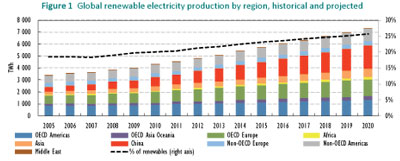Just as renewable energy is becoming widely competitive on price with fossil fuels, growth will slow over the next five years if key governments don’t get their act together on supportive policies, warns the International Energy Agency (IEA) in its Medium-Term Renewable Energy Market Report.
Last year, renewable energy (including hydro) expanded at its fastest pace yet, reaching almost 22% of global electricity generation (up from 17% in 2008), on par with natural gas, which remained relatively stable. By 2020, IEA expects renewable energy to rise to a 26% share – growing 45% – but it sees annual growth plateauing after 2014 without policy certainty. That would make it impossible to meet global climate change objectives, says IEA.

"Many renewables no longer need high incentive levels. Rather, given their capital-intensive nature, renewables require a market context that assures a reasonable and predictable return for investors. This calls for a serious reflection on market design needed to achieve a more sustainable world energy mix," explains Maria van der Hoeven, Executive Director.
In China, for example, expansion is constrained by a lack of grid integration policies, while in the European Union, there’s uncertainty regarding policies after 2020 and the build-out of a pan-European grid that facilitates integration of variable renewables.
Then there’s the US Congress which continues to support fossil fuel subsidies while it allows support for renewables to expire.
Global investment in new renewable energy capacity topped $250 billion in 2013 and is expected to average $230 billion through 2020. Besides policy uncertainties, the decline is also due to dropping costs of wind and solar technologies, which are opening up opportunities in markets like Brazil and Chile. In Brazil, onshore wind is beating natural gas in auctions because of strong resources and financing conditions, and in Chile, high irradiation levels combined with high wholesale electricity prices is opening an unsubsidized solar market.
Policies that support renewable energy used for heating and transportation greatly lag those for electricity and uncertainty is rising in the US and EU, just as the first advanced biofuel plants are coming online.
Heating homes and buildings accounts for more than half of the world’s energy consumption and is dominated by fossil fuels. Renewable energy sources provide 8% of the world’s heat, expected to grow to only 9% by 2020 without efforts on the policy side.

